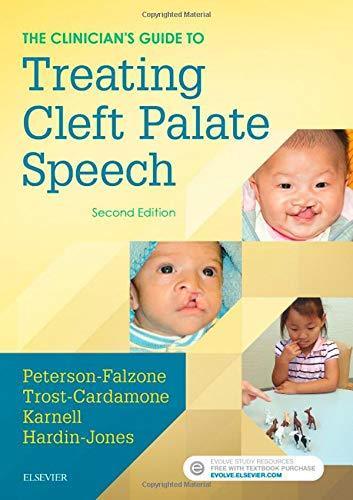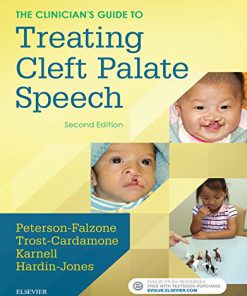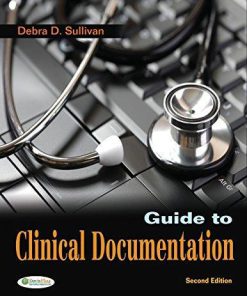The Clinician’s Guide to Treating Cleft Palate Speech 2nd Edition
$50.00 Original price was: $50.00.$25.00Current price is: $25.00.
The Clinician’s Guide to Treating Cleft Palate Speech 2nd Edition – Digital Instant Dowload.
The Clinician’s Guide to Treating Cleft Palate Speech 2nd Edition – Digital Instant Dowload.

Product details:
- ISBN-10 : 0323339344
- ISBN-13 : 978-0323339346
- Author: Sally J. Peterson-Falzone PhD (Author), Judith Trost-Cardamone PhD (Author), Michael P. Karnell PhD (Author), Mary A. Hardin-Jones PhD (Author)
Get quick access to the most up-to-date information on cleft palate speech therapy with The Clinician’s Guide to Treating Cleft Palate Speech, 2nd Edition. This textbook features an easy-to-use format ― including many bulleted lists, tables, and illustrations ― to give you instant access to the answers you need surrounding the effects of clefts and non-cleft velopharyngeal inadequacy (VPI) on communication development in children. Updated information includes new content on interprofessional team decision-making, along with the diagnosis and management of the resulting disorders.
Table contents:
1 Cleft Lip and Palate
Types of Clefts
Cleft Lip
Cleft Palate
Why Clefts Occur (Etiology)
How Clefts Form (Pathogenesis)
A Final Note
References
2 Feeding an Infant With a Cleft Palate
Specialized Bottle Systems Used with Cleft Palate
General Guidelines for Feeding
Feeding Children With Syndromes
A Final Word
References
3 Physical Management of Clefts
Perspective on Lip and Palate Surgery
Specifics of Lip and Nose Surgery
Specifics of Palate Surgery
Prosthetic Treatment of Clefts
Summary for Speech-Language Pathologists
References
4 Early Phonological Development
Normal Speech Production
Early Vocal Development and the Infant Vocal Tract
The Effect of a Cleft Palate on Early Vocal and Lexical Development
Implications for Age at Time of Palatal Surgery
Summary
References
5 Effects of Cleft and Noncleft VPI on Speech
What Is VPI?
Understanding the Causes of Cleft and Noncleft VPI
Brief Review of Normal Velopharyngeal Closure
Impact of VPI on Articulation
Adaptive Oral Misarticulations
Impact of VPI on Phonation
Summary
References
6 Other Consequences of Clefts
Dental and Orthodontic Issues
Ear Disease and Hearing Loss
Social, Psychological, and Educational Issues
References
7 The Orofacial Exam
Why “Orofacial”?
Categories of the Observations to Be Made
Equipment, Setting, and Additional Observations
Summary
References
8 Perceptual Assessment of Speech
A Protocol for Assessing Cleft Palate Speech
Analyze the Speech Sample
Correlate the Perceptual Speech Data With Orofacial Examination Findings
Interpret and Summarize the Clinical Data
Identifying and Documenting Cleft Palate Speech Errors
Diagnostic Outcomes: Case Examples
Summary
References
9 Instrumental Evaluation of Velopharyngeal Function
What Instrumentation Can Do
What Instrumentation Cannot Do
Documentation of Speech
How Instrumentation Contributes to Management Decisions
Types of Instrumentation Used in the Clinic
Instruments Used for Visualization of the Velopharyngeal Mechanism
Instruments Used for Documenting Speech and Tracking Change
How Does Instrumental Assessment Influence Management Decisions?
Summary
References
Supplemental Readings
10 Physical Management of Velopharyngeal Inadequacy
Surgical Management of Velopharyngeal Inadequacy
Prosthodontic Management of Velopharyngeal Inadequacy
References
11 Early Intervention for Infants and Toddlers
Early Monitoring and Intervention
Intervention With the Prelinguistic Child
Parents’ Expectations of Palatal Surgery
Lexical and Phonological Growth Following Surgery
Oral Motor “Exercises”: A Warning
Looking Ahead
Summary
References
12 Speech Therapy for Cleft-Related Misarticulations
Deciding What Is “Treatable” and What Is Not
Deciding on the Treatment Approach
Initiating Treatment
Parents, Teachers, and the Speech Notebook
Useful Therapy Materials
Therapy for Cleft-Related Speech Errors
Summary
References
13 Four Multianomaly Craniofacial Conditions That Include Clefts
Van Der Woude Syndrome
Pierre Robin Sequence
Stickler Syndrome
Velocardiofacial Syndrome
You may also like…
Technique - Electronics: Signal Processing
Politics & Philosophy - Social Sciences
Education Studies & Teaching - Studying & Test Preparation
Uncategorized
Medicine & Health Science
The Clinicianu2019s Guide to Treating Cleft Palate Speech E Book 2nd Edition, (Ebook PDF)
Uncategorized
Social Science













